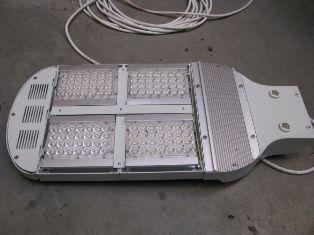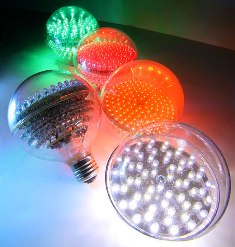Categories: Interesting Facts, Interesting electrical news, Sources of light
Number of views: 30458
Comments on the article: 1
Superbright LEDs - the technological revolution in electric lighting
 Many people know that modern LEDs more effective than incandescent lamps, and some models may argue with fluorescent lamps. But rarely does anyone think about what changes these technologies promise us.
Many people know that modern LEDs more effective than incandescent lamps, and some models may argue with fluorescent lamps. But rarely does anyone think about what changes these technologies promise us.
Promised paradise
Almost two trillion dollars - so many new LEDs will save earthlings in the next 10 years, provided they are widely implemented. In energy units, the savings will be expressed in 18.3 terawatt hours. Reducing CO2 emissions over this “LED” decade will be 11 gigatons, and oil consumption will drop by almost a billion barrels. And 280 average power plants can be closed.
Yes, professors Jung Kyu Kim and Fred Schubert from Rensselaer Polytechnic Institute approached the forecast of the future of solid-state lighting systems. They tried to go beyond the scope of saving electricity "for one house" and imagine what our world will be like, in which LEDs will get much more widespread than there is now. And most importantly, they considered what technical heights we should expect from the same LEDs in the coming years.
Recently, the broad masses, in response to "green spells," have rushed to buy compact fluorescent lamps. LEDs are still in the shade, mainly because of the excessively high cost. But this is a temporary matter. But the potential ability of LEDs to significantly circumvent the best fluorescent lamps in efficiency is worth considering. Of course, LEDs that work as indicators, components of displays, or any kind of optoelectronic devices, have practically no effect on the energy balance in the world. But lighting based on this principle can literally change it.
Revolution is coming
According to the forecast of Kim and Schubert, in the coming years we will witness a real revolution in this area. In their paper published in the journal Optics Express, Jung and Fred write about the "replacement paradigm" (that is, the total replacement of incandescent bulbs with LEDs), which can also be interpreted as a paradigm replacement. The fact is that upon reaching some critical mass of development in the field of LEDs, they will “explode” not just in a quantitative, but in a qualitative way, change in life.
How do you, say, reduce electricity consumption for lighting houses, apartments and streets by 13-17 times? Certainly you can imagine how cities and towns acquire windmills and solar panels and say to the centralized electric networks “Farewell!”. Without a strong increase in the efficiency of lighting systems, there is nothing to think about such independence - it will be too expensive.
Rensselaer scientists cite the effectiveness of lighting: good incandescent lamps - 16 lumens per watt, compact fluorescent ones - 64 (that is, the difference is four times as much), long fluorescent tubes - 80. We will add that the efficiency of modern mass-produced LEDs designed specifically for lighting is somewhere then in the area between compact and "long" fluorescent lamps. Meanwhile, scientists determined the theoretical limit for LEDs as 320 lumens per watt, and a realistic achievable parameter for the coming years - 213! (In all cases, the so-called real white LEDs necessary for home lighting are considered, since color ones are even more effective).

Baby powder saves
Last month, the American company Cree, one of the leaders in the industry, announced the creation of a prototype white LED with an efficiency of 161 lumens per watt, which is ten times higher than the average incandescent lamp! Meanwhile, serial "lighting" class LEDs from different companies have already crossed the threshold of 100 lumens per watt.
Beauty, but when will they cut prices? Here I must say that in the "LED science" in recent years a lot of interesting things have been happening. Scientists are experimenting with new materials.It should be clarified that white LED lamps are made using two technologies: either they put three tiny LEDs with red, green and blue rays side by side, receiving "pseudo-white" light; or they take an LED emitting an ultraviolet (sometimes blue) flux, and cover it with a layer of phosphor, which converts this radiation into white light, more or less close to natural.
The first approach is poorly distributed and expensive. And still - this is not the same as real white. The second LED is less efficient. And yet - its phosphor contains a complex composite containing, among other things, yttrium and cerium. This is one of the reasons for the high cost of lighting white LEDs.
But recently, physicists from Duke discovered that an ultrafine powder of zinc oxide (a component of baby powders) with the addition of sulfur in the right proportion, provided that the nanostructure is formed correctly, can effectively transform ultraviolet into very bright and clear white light. In this case, the white component turned out to be 1000 times brighter than ultraviolet in the output radiation.
Today
Kim and Schubert write that the distribution of LEDs should go much further than simple home lamps. Solid-state emitters are able to change the technogenic environment surrounding us. Indeed, in various LEDs, it is possible to control the spectrum with high accuracy, the parameters of the divergence of the light beam, its polarization, and radiation oscillations in time. In general, almost everything.
With the assistance of LEDs, it is possible to treat a number of diseases and carry out interesting scientific experiments, stimulate plant growth in conditions that are not typical for them, and create interactive safe roads.
And this means that with the help of LEDs, it is possible to treat a number of diseases and conduct interesting scientific experiments, stimulate plant growth in conditions that are not typical for them and create interactive safe roads, and so on. With such flexibility of settings - all paths are open. Together, scientists called it “smart lighting,” and so that beautiful words do not contradict business, the Rensselaer Institute, together with the universities of Boston and New Mexico, created a research center - Smart Lighting Research Center.
The National Science Foundation has already allocated $ 18.5 million to partners for the next five years to implement LED daydreaming. Therefore, the "ode to the LEDs" of Rensselaer professors can be considered an announcement of future victories of the center. And since this topic is not only dealt with at the universities and institutes mentioned above, the upcoming “paradigm shift” can be considered a settled issue. Whether it will take 10 years, or a few more is another question.

See also at bgv.electricianexp.com
:
